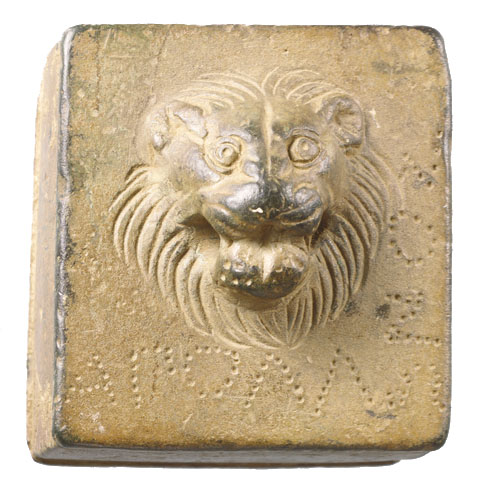
-
Copyright credit: J. Paul Getty Museum

ARCHAEOLOGICAL DESCRIPTION OF THE WEIGHT
Authority
Apollo
Mint
Denomination
1 Mina
Material
Copper alloy (bronze or brass)
Manufacture
Cast
Shape
Square
Length
5.87 cm
(2.3125 inch)
Width
5.56 cm
(2.1875 inch)
Height
2.22 cm
(0.875 inch)
Metrology
| Mass (g) | Mass (grain) | Date of measurement | Reference | fragmented | cleaned | reference weight |
|---|---|---|---|---|---|---|
| 455.80 | - | - | Killen 2017 | No | No | Yes |
Iconography
| Symbol | Technique | Direction | Position | Number | Synecdoche |
|---|---|---|---|---|---|
| Lion | Relief | Head |
Wear
Corrosion
Handle
No
Suspension hole
No
Recarved mould
No
Recarved weight
No
Intentionally destroyed
No
Archaeological description
The head of a lion decorates this weight. The ancient artist carved the lion in high relief, carefully incising details of the face and mane. A dotted inscription in Greek reads "of Apollo." It was a common practice in the ancient world for official weights to be kept in temples for safekeeping. The inscription implies that this weight was kept in a temple of Apollo, the god of music and prophecy. Although Apollo was most frequently associated with the lynx, the god was also connected with the lion as a sacred animal.
The back of the weight is plain except for a large rectangular hollow, which has been filled with lead. Signs of scraping show that the weight was calibrated. Flat, plaque weights were normally used in a simple balance scale, but here, the lion's mouth has been drilled out at the sides, perhaps for the insertion of a ring handle. Such a handle or loop would also allow the weight to be used on a steelyard scale. The piece weighs a mina, the standard common in the eastern Mediterranean region in Late Hellenistic and early Roman Imperial times.
The back of the weight is plain except for a large rectangular hollow, which has been filled with lead. Signs of scraping show that the weight was calibrated. Flat, plaque weights were normally used in a simple balance scale, but here, the lion's mouth has been drilled out at the sides, perhaps for the insertion of a ring handle. Such a handle or loop would also allow the weight to be used on a steelyard scale. The piece weighs a mina, the standard common in the eastern Mediterranean region in Late Hellenistic and early Roman Imperial times.
Autopsy
No
INSCRIPTION
| Language | Technique | Legend type |
|---|---|---|
| Greek | Dotted | Authority |
Fac simile
Edition
Ἀπόλλωνος
Monogram
ARCHAEOLOGICAL CONTEXT
Findspot (region)
Findspot (site)
context
CIRCUMSTANCES OF ACQUISITION
Region
City
Date of first acquisition
circumstances
Gift of Barbara and Lawrence Fleischman (New York, 1925 - New York, 1997) to the J. Paul Getty Museum in 1996. Sold to Barbara and Lawrence Fleischman in 1988, Fritz Bürki & Son (Zurich, Switzerland).
DATING OF THE WEIGHT
Curatorial Section
GREEK
,
ROMAN
Time frame
FROM
-200
TO
100
Comments on Chronology
1st century B.C. - 1st century A.D.
COLLECTION HISTORY
Collection
| Name | Date of acquisition | Inventory number |
|---|---|---|
| Fleischman Collection | Jan. 1, 1988 | F6 |
| Getty Museum – Getty Villa (Malibu) | Jan. 1, 1996 | 96.AC.183 |
Bibliography
| Reference | Page/Column | Reference (number) | Plate / Figure | Comment |
|---|---|---|---|---|
| True and Hamma 1994 | 278 | 141 | ||
| Bodel and Tracy 1997 | 11 | (non vidi) | ||
| Getty Museum 1997–98 | 65 | |||
| Mattusch 2014 | 92, 112-113, 116 | 79 | (non vidi) | |
| Killen 2017a | 285 | Appendix 2, Löwe, 2 | None | (possible attribution to Miletos) |
VARIA
Additional comment
Roman weight, Eastern Mediterranean.
Killen 2017: Die Verbindung von Löwe und Apollon lässt zunächst an Milet denken. Jedoch konnte für Milet das Monogramm des Ethnikons als Parasemon nachgewiesen werden. Außerdem ist der milesische Löwe nur in der Frühzeit als frontaler Kopf dargestellt, später eher im Profil oder als ganze Figur. Die Inschrift könnte zudem darauf hinweisen, dass es sich um ein Votiv handelt; damit wäre die Deutung als Parasemon auszuschließen.
Killen 2017: Die Verbindung von Löwe und Apollon lässt zunächst an Milet denken. Jedoch konnte für Milet das Monogramm des Ethnikons als Parasemon nachgewiesen werden. Außerdem ist der milesische Löwe nur in der Frühzeit als frontaler Kopf dargestellt, später eher im Profil oder als ganze Figur. Die Inschrift könnte zudem darauf hinweisen, dass es sich um ein Votiv handelt; damit wäre die Deutung als Parasemon auszuschließen.
Permalink